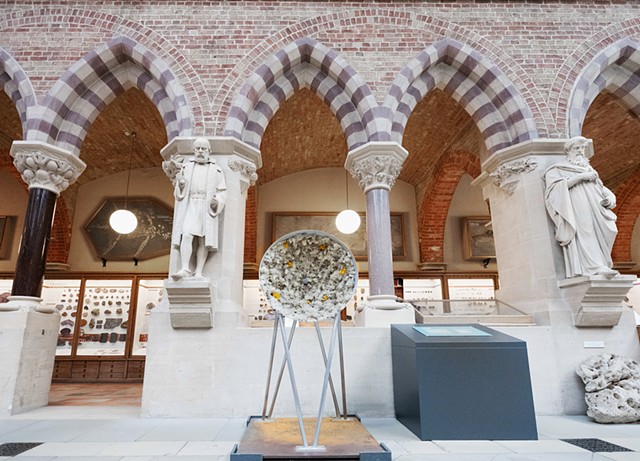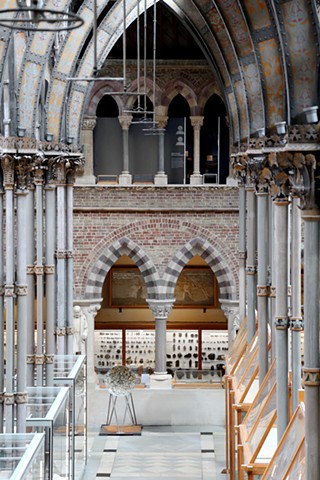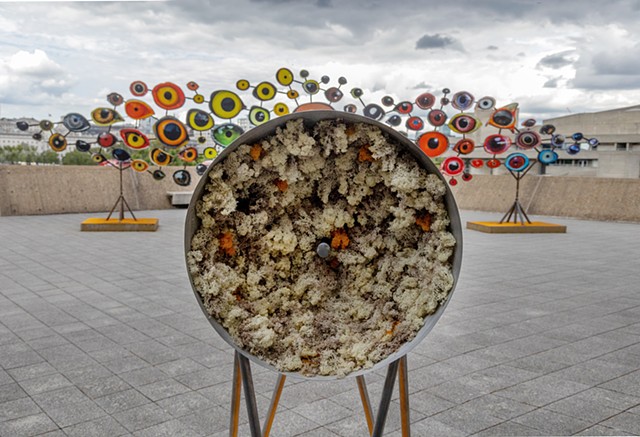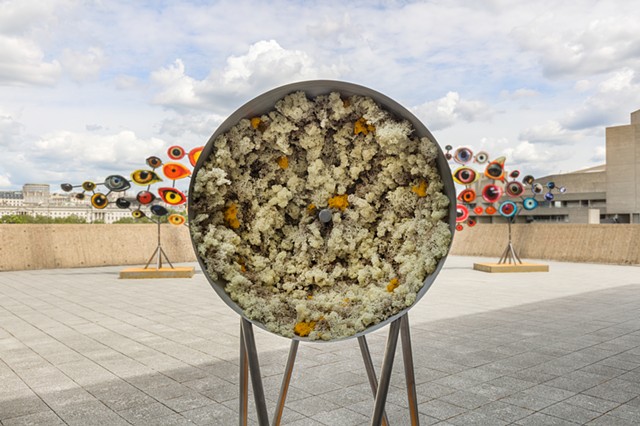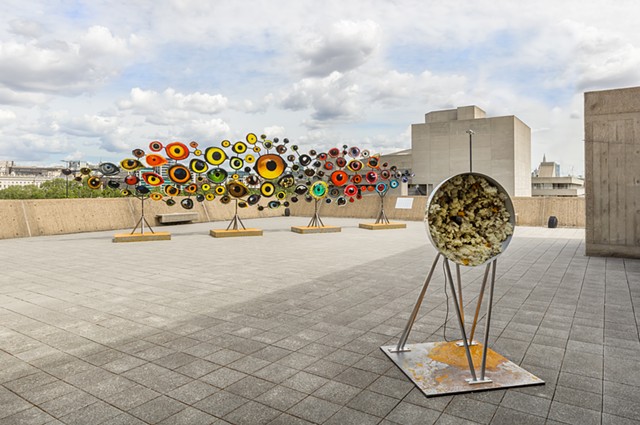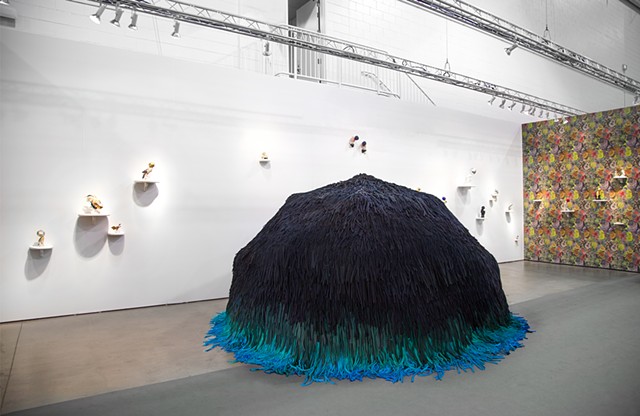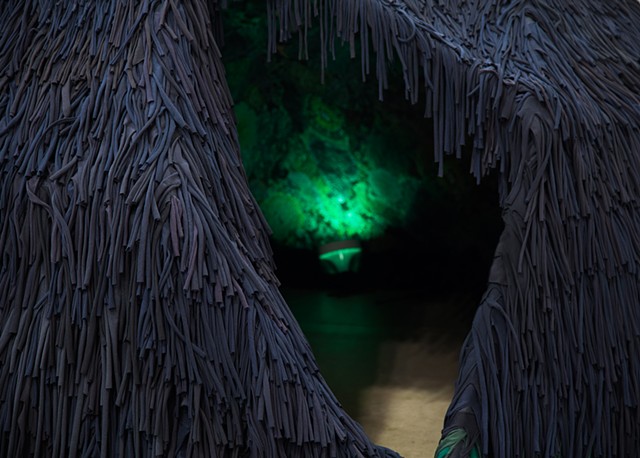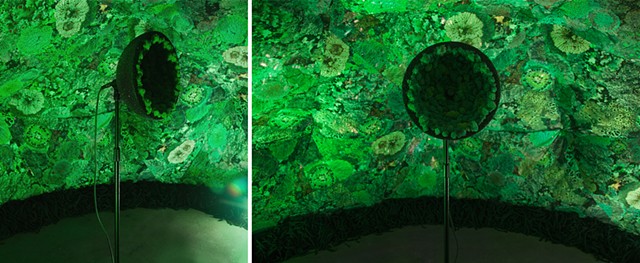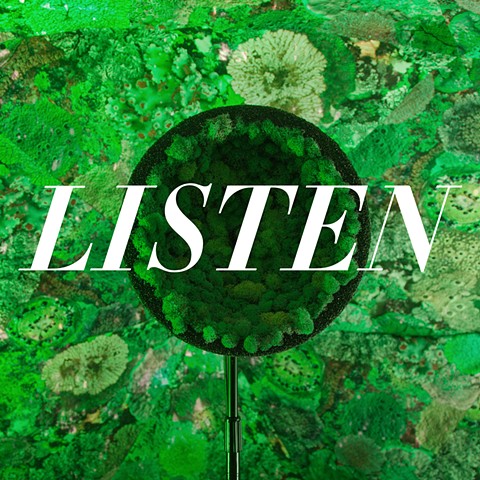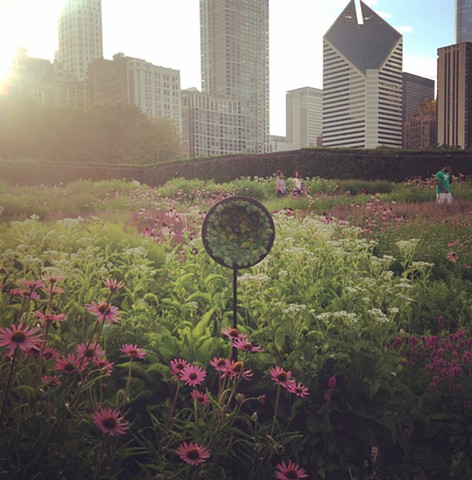Tell it to the Birds
| Jun–Sept 2023 : Hayward Gallery at London's Southbank Centre |
| Oct–Dec 2023 : Oxford University Museum of Natural History |
| May–Oct 2024 : The Aviary at Waddesdon Manor|
Tell it to the Birds was recreated with a new set of bird species for the exhibition Dear Earth: Art & Hope in a Time of Crisis. The work subsequently traveled to the Oxford University Museum of Natural History and will continue to tour the UK.
| July 2015 : Millennium Park, Chicago |
Tell it to the Birds inhabited the Mylayne Pavilion in Millennium Park's Lurie Garden for a special one day event, organized by The Art Institute of Chicago & The Arts Club of Chicago alongside their exhibition of avian photographer Jean-Luc Mylayne, Mutual Regard.
| Sept 2014 : EXPO Chicago |
Tell it to the Birds is an attempt to bridge the experiential gap between human and non-human animal minds. Created as Artist-in-Residence with environmental advocacy non-profit Natural Resource Defense Council (NRDC), the project debuted at NRDC's booth at EXPO Chicago: the contemporary art fair held each year on Chicago's Navy Pier and attended by over 35,000 people.
The main component of the exhibit, the eponymous work Tell it to the Birds, is a 10ft interactive sculptural-structure in which visitors were invited to tell a secret to the natural world. Guests used the provided Field Guide, which doubled as a take-home poster, to choose from one of 11 threatened and endangered birds. Entering into a dwelling-like dome, the form of which suggests animal-built structures and utopian architectural forms, they find a forest-scented lichen 'dish' concealing a microphone. Within the darkened, private interior, each person is invited to ‘tell it to the birds‘ — to confess something to the natural world that they feel other people or the human world might not understand. Custom software live “translates" their words into birdsong, heard both inside and outside the structure — yet only the speaker knows the meaning of their song.
Birds sing to communicate with each other; we can only imagine what their subjective experiences of their songs might be. Although, birdsong is not intended for humans, it has long fascinated us, inspiring musicians like Vivaldi, Beethoven, Pink Floyd and Kate Bush to ‘quote’ birds in their compositions.
Despite the important role birds play in our environment and in popular culture, they are being pushed to the edge by human expansion. Ecological threats such as habitat loss, oil and gas development, and climate change now threaten 12% of birds worldwide and over 30% of domestic US bird species. Eleven of these unique birds and their calls are featured in Tell it to the Birds.
Though the shared ‘secret’ is entirely up to the participant — be it mundane or profound — the suggestion remains that we may wish to confess something to the natural world about our relationship with nature itself — to speak of a lack, a trespass, a neglect. It is common to hear that many of us felt closer to nature when we were children. Literally closer to the earth, we crouched downward to examine beetles, pick up feathers and to smell dense piles of moss. We picked dandelions that grew up through the pavement. We were not concerned about getting dirt under our nails. As adults, however, many of us find it is no longer ‘sensible’ to investigate the earth. We no longer speak back to birds. Many of us have forgotten our intimate connection to our former world, having been tasked by ‘growing-up’ – moving from the wild ways of childhood into the studied and arranged culture of the adult.
I would like to argue that this is a false dichotomy. Even in the most urban of cities, goldfinches migrate through in the fall, coyotes run the railroad tracks, and spiders weave intricate webs on the windows of skyscrapers. And even within those skyscrapers, nature is alive because we are still (and always) embedded within our animal bodies. We are blood, bone, guts, bacteria — we are multitudes, ourselves an ecosystem — mortal and fully animal, no matter how our culture may try to ignore this fact. And so, I suggest with this installation, the need to reclaim our animal selves, and to recognize and respect our kinship with the others with whom we share this planet.
By infusing human meaning and emotion into the language of birds, traditional semantics become destabilized. This opacity between human and bird speech is a poetry of slippage. Though the act of translation, by its nature, is always inadequate, it also creates an open-ended and unpredictable channel for connection, suggesting an implicit kinship between speakers. This act recognizes the inviolable difference of the other, while also attempting the first and necessary step of any boundary crossing.
Tell it to the Birds raises questions about what we mean when we say 'language.' Linguists such as Noam Chomsky assert that language exists in an evolutionary continuum from non-human to human animals. Once claimed to be something that separated humans from animals, language or at the very least, the need to communicate is something that we now know we share with many living beings. I'm interested in what it means to translate across the species boundary, beyond an anthropocentric perspective; to communicate with and attempt to understand new kinds of mind, intelligence and culture in non-human species — and the immeasurable value that we might find there.
This act of cross-species empathy is so deeply important today, because how human beings feel about a species is becoming one of the most important factors in that species’ survival. Human imagination has become an ecological force. Taking cues from eco-phenomenology and bio-semiotics, I suggest that — while we may never be able to completely understand the subjective experience of mind, or umwelt, of a bird (or any other being) — by experiencing our own words spoken in the voice of these beautiful others, a tenuous thread of connection is extended across that gap.
Press for Tell it to the Birds:
The Oxford Scientist • "Echoes in silence: the lasting resonance of Tell it to the Birds" by Ayaka Hogg
From the above: Just on the next walkway, a model of the Dodo sat in a cabinet. The museum owns the last soft tissue remains of this species in the world—a creature lost to one of the most famous extinctions caused by humans.
Two cries for help sitting just meters apart in the walls of the museum: one by Jenny Kendler told through birdsong, and one from the Dodo, told through history. The birdsong itself lasts only for as long as the secret we whisper into the microphone—without our voices they are voiceless. The power we hold, as people, means we must be nature’s spokesperson. At a time where efforts to slow the decline of our bird populations are not being met with the attention they deserve, conservation efforts and installation art just like Kendler’s ‘Tell it to the Birds’ may be the only tools we have left to rescue them before time runs out.
Newcity • "Social justice at an art fair?" by Matt Morris
Chicago Tribune • "Jenny Kendler puts ethics, empathy in art" by Lori Waxman
The artist would like to credit the original recordists of many of the bird songs used in this project, which were shared under Creative Commons License through the remarkable Xeno-canto project.
2014 (US threatened species):
Nick Athanas (Columbian Mountain Grackle)
Oswaldo Cortes (Colombian Mountain Grackle)
Doug Hynes (Short-billed Dowitcher)
Jonothon Jongsma (Wood Thrush)
Paul Marvin (Bendire’s Thrasher)
Andrew Spencer (Bendire’s Thrasher, Bicknell’s Thrush, Black-capped Vireo, Greater Sage Grouse, Horned Lark, Lesser Prairie Chicken, Red Knot & Russet-bellied Spinetail)
Martin St Michel (Wood Thrush)
2023 (UK and ZSL threatened species):
Andrew Spender (Red Knot)
Susanne Kuijpers, Bodo Sonnenburg (Common Nightingale)
Dominique Guillerme (Mistle Thrush)
Ian Roberts & Grzegorz Lorek (Eurasian Skylark)
Stanislas Wroza, Guillaume Bigayon & Ulf Elman (Northern Wheatear)
Fredrik Narfström (Common Linnet)
Marcin Urbański (Marsh Warbler)
Philippe Verbelen (Grey Parrot)
Uncredited YouTube Video (White Rumped-Shama)
The artist would also like to thank environmental non-profit NRDC and most especially Elizabeth Corr, Associate Director of Arts & Cultural Partnerships for the support of the original 2014 work, alongside Alex Inglizian at Experimental Sound Studio and the Hayward Gallery's Commissioning Committee for the 2023 work.
